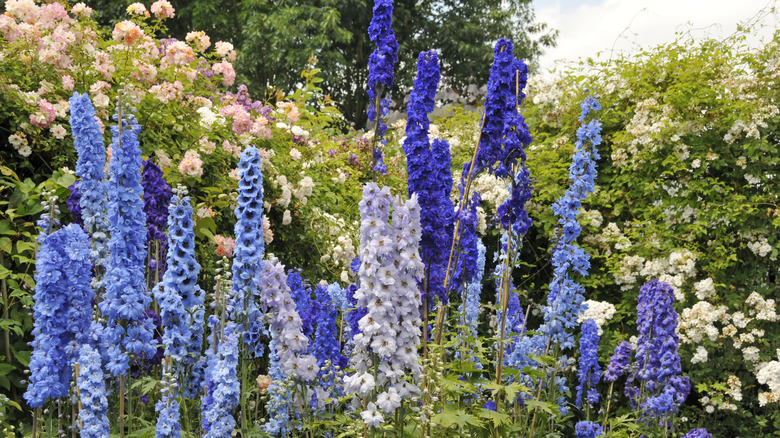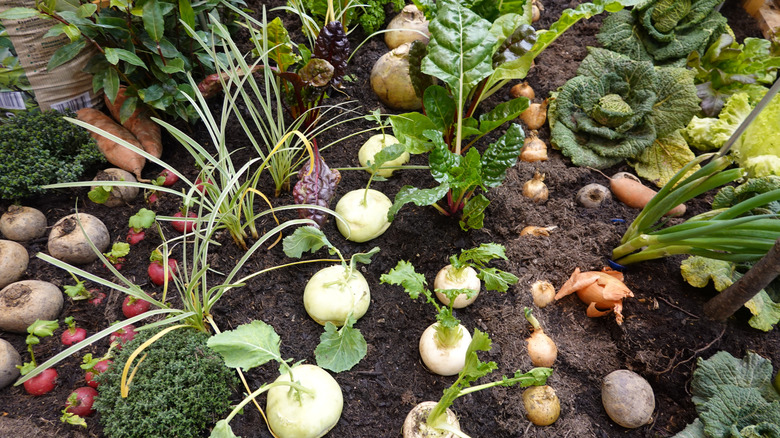The Disadvantages Of Growing Larkspur And Beets Together (& Better Plant Alternatives)
A bountiful and diverse companion garden can keep your vegetable drawer and flower vases stocked year-round. Just like humans, plants that share a garden bed can form community and mutually beneficial relationships. Companion planting can benefit your garden by warding off unwanted pests, minimizing weed growth, and enriching soil health. Unfortunately, not all matches are meant to be.
Some plant pairs shouldn't grow next to each other, like beets (Beta vulgaris) and larkspur (Delphinium spp.) Though both plants thrive in USDA zones 2 through 11, the larkspur plant's bright and expansive blooms experience quick growth but are not a good match for beet's love of full sunlight. Larkspurs are also known to be competitive with both sunlight and essential nutrients and their tall stature can overshadow beets, stunting their growth.
Safety should also be considered when choosing larkspur for your garden. The beautiful flower is deadly for your beloved pets and loved ones if consumed. All parts of the plant are highly toxic, and ingesting larkspur can be fatal to both humans and animals. It's a good idea to avoid planting larkspur close to vegetables, like beets, due to the poisonous alkaloids present throughout the plant's lifecycle. Thankfully, plenty of other plants thrive alongside both beets and larkspur, and with a little digging, both plants can meet their companion garden match.
Flowers that grow well with larkspur
Despite not having a place in the vegetable garden, the larkspur plant's abundant blossoms are beautiful additions to flower beds and container gardens. Both annual and perennial flowers can thrive next to larkspur. Sunflowers, poppies, and foxgloves, can come together with larkspur to create a harmonious landscape.
Companion planting larkspur alongside other flowers also comes with added benefits. Yarrow is a natural pest repellent, and may deter snails and slugs from feasting on larkspur's leaves. Surrounding larkspur with other sturdy plants like hollyhock or Joe Pye Weed can help protect it from the elements.
Beets aren't the only plant to avoid when choosing your larkspur's neighbor. Aquatic plants like water hyacinths and Cattails need more moisture than larkspurs prefer. Their conditions are too wet for the plant to adequately flourish. Instead, opt for plants with a similar preference to well-drained, neutral pH soil.
Companion planting with beets
When seeking a companion plant for your beets, your options are vast and versatile. Like larkspurs, finding a compatible match can result in fewer pests, healthier soil, and happier plants. One of the most popular companion plants for beets are onions. These alliums emit a natural pest repellant that protects beets from common nuisances like aphids. The plant's non-obstructive growth patterns allows both to prosper in adequate sunlight. They also grow well with other members of the allium family like garlic and leeks.
Introducing flowers and herbs into nearby garden beds can encourage the presence of pollinators and insects that aid in pest control. Nectar from flowering plants like calendula lures predatory insects that feed on common pests. They also bring a pop of color and can encourage honeybees to participate in your backyard ecosystem. Planting beets next to peas is another great way to encourage healthy growth. Peas help by supplying beets with additional nitrogen absorbed from the air and will not interfere with beets' sunlight. But, there can be too much of a good thing. Plants like pole beans can produce too much nitrogen, resulting in stunted plants and minimal growth. Other vegetables to use caution with when planting near beets include brassicas like bok choy or cabbage. These vegetables are also highly competitive and can quickly deplete soil nutrients, leaving your beet plants undernourished.
Finding the perfect match
When designing your companion garden, it can feel overwhelming at first. But with proper planning, even the most finnicky plants can meet their perfect match in the garden. From larkspur to beets to brassicas, ensuring you are setting your plants up for success by planting them next to neighbors they can easily coexist with is key.
An easy way to make sure plants can thrive in the same climate is by taking into account the plants preferred levels of sunlight and soil type. Beets prefer cooler temperatures, full sunlight, and moist soil with good drainage. They grow best next to plants that won't overpower and will allow them to get adequate nutrients.
Larkspurs prefer similar conditions to beets but should not be planted near any plants intended for consumption due to the risk of poisoning. Despite these conflicts, both plants can flourish in your garden. With intention and planning, beets and larkspur can coexist — just place them in their respective corners.



